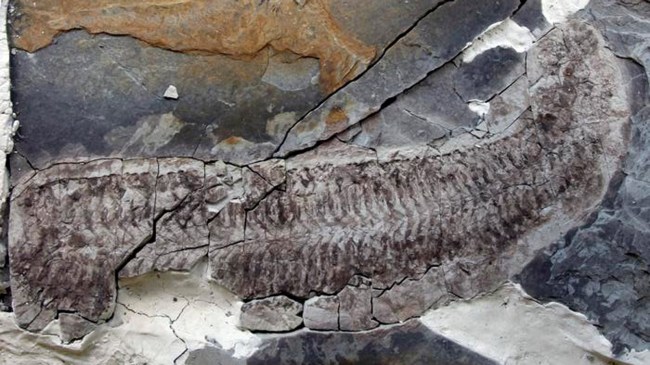University of Leicester
A paleontologist discovered a new species of fossil from 444 million years ago she calls an “inside-out, legless, headless wonder.” This new species of multi-segmented fossil and has officially been named Keurbos susanae, or “Sue” for short.
The discovery of this new species is a result of 25 years of work by a palaeontologist named Sarah Gabbott. Gabbott is a professor at the University of Leicester School of Geography, Geology and the Environment.
“‘Sue’ is an inside-out, legless, headless wonder,” Gabbott stated in a press release announcing the find. “Remarkably her insides are a mineralised time-capsule: muscles, sinews, tendons and even guts all preserved in unimaginable detail. And yet her durable carapace, legs and head are missing – lost to decay over 440 million years ago. We are now sure she was a primitive marine arthropod but her precise evolutionary relationships remain frustratingly elusive.”
Today about 85% of animals on Earth are arthropods, and they include shrimps, lobsters, spiders, mites, millipedes and centipedes.
They have an excellent fossil record stretching back over 500 million years but usually their fossil remains are of their external features, whereas ‘Sue’ is the complete opposite because it is her insides that are fossilized.
The fossil was found in the Soom Shale, a band of silts and clays located approximately 250 miles north of Cape Town in South Africa.
“The conditions in the sediments where Sue came to rest were toxic in the extreme,” the press release states. “There was no oxygen but worse than that there was deadly (and stinking) hydrogen sulphide dissolved in the water. The researchers suspect that a strange chemical alchemy was at work in creating the fossil and its unusual inside-out preservation.”
The downside of this unique method of preservation is that it “makes it difficult to compare her to other fossils of the era and so it remains a mystery how she fits into the evolutionary tree of life.”
On the plus side, we’re pretty sure “Sue” isn’t a whole new, just discovered life-form.
“This has been an ultra-marathon of a research effort,” said Gabbott. “In a large part because this fossil is just so beautifully preserved there’s so much anatomy there that needs interpreting. Layer upon on layer of exquisite detail and complexity.”
Content shared from brobible.com.

